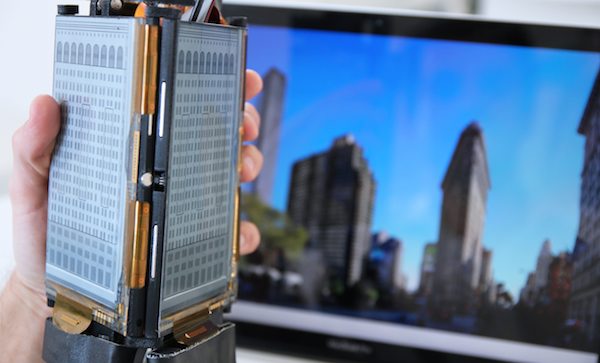
[Image above] Credit: Human Media Lab; Youtube

PaperFold, a “ground-breaking foldable smartphone.” Credit: Human Media Lab; Youtube
Human Media Lab at Queen’s University (Canada) unveiled a new “ground-breaking foldable smartphone” prototype—seemingly part-smartphone, part-smartmap, part-smartreader, and all around nifty—at a tech conference early this week.
The new device, called PaperFold, features three flexible touch-sensitive electrophoretic magnetic displays that can be folded, moved, and detached, providing a lot of flexibility for different applications. What’s really cool is that it seems to be electronically self-aware—the device can detect its shape and adjust its display and functionality accordingly.
“In PaperFold, each display tile can act independently or as part of a single system,” says Roel Vertegaal, computing professor at Queen’s and director of the Human Media Lab, in a press release. “It allows multiple device form factors, providing support for mobile tasks that require large screen real estate or keyboards on demand, while retaining an ultra-compact, ultra-thin and lightweight form factor.”
For example, flattening all three connected displays pulls up a Google map across all screens, but folding the sides down calls up Google Earth view. What’s perhaps even more impressive is that standing the screens upright and folding them into the shape of a building at that location on the map draws up a Google SketchUp of the building, which can then be printed as a 3D architectural model. Watch the video above to see more of the device’s snazzy features.
“The development of electronic paper computers that can adopt similar qualities to paper has been an enduring research goal for our team,” says Vertegaal. “Books use folding as both a navigational and space saving technique, and paper maps have malleable display sizes. The PaperFold smartphone adopts folding techniques that makes paper so versatile, and employs them to change views or functionality of a smartphone, as well as alter its screen real estate in a flexible manner. PaperFold demonstrates how form could equal function in malleable mobile devices.”
PaperFold was unveiled at this week’s ACM CHI 2014 conference, a leading meeting for new tech interaction techniques, in Toronto. To read the full conference abstract, check out this pdf.
No word yet on when and if the prototype might make it to retail. But if so, I’m imagining exploring a new city in whole different way with the help of the device and these tickling Super Shoes.
Do you think this new smartphone lives up—is it ground-breaking and revolutionary?
Author
April Gocha
CTT Categories
- Electronics
- Material Innovations
Spotlight Categories
- Member Highlights



